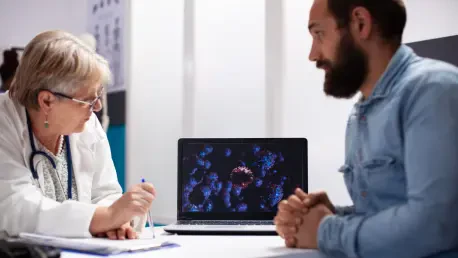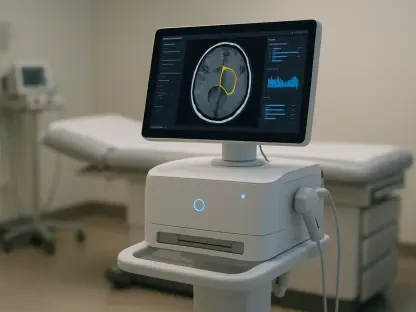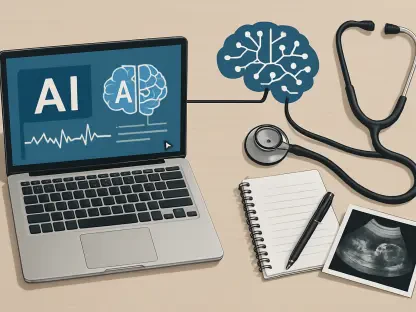Imagine a scenario where a routine eye exam could detect a potentially blinding condition long before any symptoms appear, preserving a patient’s vision through timely intervention. A remarkable advancement from the University of Waterloo is turning this possibility into reality with a cutting-edge artificial intelligence (AI) tool designed to dramatically improve the clarity of eye images. This technology targets images produced by optical coherence tomography (OCT), a non-invasive method that provides detailed cross-sectional views of the eye, especially the cornea. Historically, the quality of these images has been compromised by blurriness and grainy distortions, often masking critical details essential for accurate diagnosis. This innovative AI model offers a solution, paving the way for earlier and more precise identification of eye conditions, and potentially transforming the landscape of ocular health care with sharper, more reliable imaging.
Revolutionizing Eye Imaging with AI
The Challenge of OCT Imaging
Optical coherence tomography (OCT) stands as a cornerstone in modern eye care, employing light waves to generate intricate images of the eye’s internal structures without the need for invasive procedures. Despite its value, a significant hurdle persists when imaging at the cellular level: the images often suffer from a lack of clarity due to a blurring effect and a grainy interference known as speckle noise. These imperfections can obscure vital details, making it challenging for clinicians to detect subtle signs of diseases such as corneal dystrophies or infections. This distortion has long impeded early diagnosis and effective monitoring of treatment progress, creating a pressing demand for enhanced image processing techniques. The frustration of peering through such flawed visuals has been likened to reading text behind frosted glass, a barrier that can delay critical interventions and impact patient outcomes. Addressing this issue has been a priority for researchers aiming to elevate the standard of diagnostic precision in optometry.
The impact of poor OCT image quality extends beyond mere inconvenience, often resulting in missed or delayed diagnoses that can allow eye conditions to progress unchecked. For practitioners, the inability to discern fine cellular details can mean the difference between early intervention and managing advanced disease stages, which are far more complex and costly to treat. This challenge is particularly acute in conditions affecting the cornea, where early signs are often subtle and easily masked by image noise. The persistent struggle with these imaging limitations has driven innovation in the field, pushing researchers to explore new technologies that can strip away distortions and reveal the hidden details crucial for accurate assessments. At the University of Waterloo, a dedicated team has taken on this issue, recognizing that overcoming these visual barriers could unlock significant improvements in patient care and diagnostic reliability across eye care practices worldwide.
A Breakthrough with PIDM
At the forefront of this technological leap is the Physics-Informed Diffusion Model (PIDM), an AI innovation that redefines image enhancement by grounding its processes in the physics of light interaction with eye tissues. Unlike conventional AI tools that may inadvertently introduce fabricated details during reconstruction, PIDM is designed to ensure accuracy by accounting for real-world distortions like light scattering and reflection. Developed by researchers at the University of Waterloo, this model was meticulously trained to understand and reverse the effects of defocus and speckle noise, resulting in images that are not only clearer but also clinically dependable. Tests on human cornea and plant tissue images captured via OCT have demonstrated PIDM’s ability to produce sharp, detailed visuals that surpass traditional reconstruction methods. This advancement, published in IEEE Transactions on Biomedical Engineering, marks a significant stride toward trustworthy imaging for medical diagnostics.
The significance of PIDM’s physics-based approach cannot be overstated, as it addresses a critical flaw in standard AI models: the risk of generating unrealistic or “hallucinated” details that could mislead clinicians. By embedding scientific principles into its framework, PIDM ensures that each step of the image refinement process aligns with the actual behavior of light in biological tissues. Dr. Alexander Wong, a key figure in the research, has highlighted how this method minimizes errors, offering images that practitioners can rely on for precise analysis. The model’s ability to reveal crisp cellular outlines and intricate internal structures has shown promise in controlled testing environments, setting a new benchmark for image quality in ocular diagnostics. As a result, PIDM stands poised to enhance the confidence of eye care professionals in their diagnostic decisions, potentially reducing the likelihood of oversight in critical cases.
Impacts and Future Possibilities
Transforming Diagnosis of Corneal Diseases
The cornea plays an indispensable role in vision, acting as the eye’s clear front layer, and diseases affecting it—such as keratoconus or corneal infections—can lead to severe visual impairment if not identified early. With the advent of PIDM, the enhanced clarity of OCT images empowers doctors to detect minute abnormalities that might otherwise remain hidden beneath layers of noise and blur. This breakthrough means that subtle changes in corneal structure, often the first indicators of disease, can now be spotted with greater accuracy, enabling interventions at the earliest possible stage. Dr. Lyndon Jones, a respected voice in optometry at Waterloo, has emphasized the potential of this tool to improve patient outcomes significantly. By catching issues before they escalate, PIDM could reduce the risk of progression to more serious conditions, offering a lifeline to countless individuals and reinforcing the importance of advanced imaging in routine eye care.
Beyond early detection, the implications of PIDM for corneal disease management are profound, as clearer images facilitate more precise monitoring of treatment efficacy over time. For clinicians, this translates into the ability to tailor therapies based on detailed visual feedback, adjusting approaches as needed to optimize results. The technology’s capacity to reveal previously obscured details also supports better communication with patients, allowing doctors to explain conditions and treatment plans with greater clarity using high-quality visuals. As OCT becomes increasingly integrated into eye care practices globally, tools like PIDM could accelerate its adoption by making the technology more effective and accessible to practitioners of varying expertise levels. This shift promises to elevate the standard of care, ensuring that more patients benefit from timely and accurate diagnoses, ultimately preserving vision and enhancing quality of life for those at risk of corneal ailments.
Expanding Horizons Beyond the Cornea
While the immediate application of PIDM centers on improving corneal imaging, the research team at Waterloo envisions a broader scope for this technology, including its use in imaging the retina to aid in diagnosing conditions like macular degeneration and diabetic retinopathy. The retina, critical for central vision, is often affected by diseases that require precise imaging for effective management, and PIDM’s ability to enhance clarity could prove invaluable in these contexts. Extending the model to incorporate additional physics principles tailored to different eye tissues represents a logical next step, potentially benefiting millions of patients worldwide who suffer from vision-threatening conditions. The groundwork laid by this research, inspired by the late Dr. Kostadinka Bizheva, sets a compelling precedent for adapting AI tools to meet diverse diagnostic needs within ophthalmology, hinting at a future where comprehensive eye imaging is both sharper and more reliable.
Moreover, the integration of physics into AI models like PIDM offers a blueprint for innovation beyond ocular health, with potential applications in other areas of medical imaging where noise and blurring pose similar challenges. Dr. Alexander Wong has noted that embedding scientific understanding into AI enhances the reliability of results, opening doors to more effective diagnostic tools across various health domains. This approach could inspire advancements in imaging technologies for organs and tissues outside the eye, addressing longstanding barriers to accurate visualization in fields like cardiology or oncology. As interdisciplinary efforts continue to merge physics, engineering, and medicine, the lessons learned from PIDM’s development could catalyze a wave of technological progress, ultimately improving health outcomes on a global scale. Looking ahead, the ongoing refinement and expansion of such models promise to reshape the landscape of medical diagnostics, ensuring that precision and clarity remain at the forefront of patient care.









